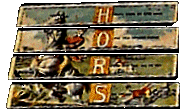Though 18th century jigsaw puzzles in the main had simple non-interlocking pieces, each puzzle had to be made by hand. Linda Hannas, The Jigsaw Book, New York: The Dial Press, 1981, p. 16, writes that some American innovative puzzle makers attempted to lower their manufacturing costs by marketing an alternative to puzzles composed of irregularly cut pieces. Using a European technique for horizontally cutting a picture into three equal parts, Lyman and Curtiss of New York City (for example) produced a boxed puzzle they called an Educational Sliced Puzzle. Not only could children use this type of puzzle to visually identify an animal, but manufacturers claimed that children could also learn to spell by using such a puzzle.

An edition in 1900 by Selchow and Righter titled Sliced Animals Improved has the subtitle Or Spelling Made Easy. S&R first patented this type of puzzle in 1875, offering such titles as Sliced Birds, Sliced Objects, Sliced Nations, and more. To find out more about this puzzle, click on the picture to the right.
By the 19th century, it was not unusual for a number of puzzle makers to produce a jigsaw puzzle with the same subject. One of these was the steam locomotive, a popular subject at the time. Milton Bradley called their 1870 version The Smashed-up Locomotive: A Mechanical Puzzle for Boys. McLoughlin Brothers called their 1898 version The Locomotive Scroll Puzzle. As "travel" became increasingly important to people, puzzles with pictures of ships and eventually autos were produced.

This jigsaw puzzle was donated to the Museum in 1983. The donor indicated that the puzzle was bought about 1910. It is made of heavy cardboard and when assembled it is 23.5cm long x 39cm wide (or 9.25" x 15.4"). There are 24 internal pieces, and 8 edge pieces. Each interlocking piece is about 6.5cm, but the pieces were not cut to fit as snuggly as contemporary jigsaw pieces. The box top corners have metal connectors, and the box bottom corners are reinforced with linen tape. It is not known if these connectors and reinforcements were part of the original packaging. Information printed on the box top indicates the puzzle was copyrighted by McLoughlin in 1898. The picture is of the famous New York Central Locomotive 999 which set a world speed record in the 1890s.
Anne Williams reports that McLoughlin reused its artwork over and over. They might have used 6 illustrations in a children's book, then used the same 6 illustrations for a cube puzzle, and also used these same illustrations for individual jigsaw puzzles. McLoughlin's periodic sales catalogues between 1900 and 1920 show a number of different "locomotive puzzles". Williams owns a McLoughlin "locomotive puzzle" that is part of a three puzzle set, e.g. - a horse-drawn pumper, an automobile, and a locomotive. The locomotive puzzle picture is similar, but the puzzle is 25.7cm x 42cm (10.1" x 16.5") and is only 24 die-cut pieces. There is no date on the box, but the die-cutting plus the automobile image led her to date that set around 1910-1915.
Linda Hannas, in The Jigsaw Book, New York: The Dial Press, 1981, Chapter 6, Going Places, includes an illustration of another edition of the locomotive puzzle.

Another type of 19th century jigsaw "type" puzzles were made of sliced or cut-up checkerboards. Anne Williams says that these puzzles are not jigsaw puzzles although the pieces have irregular shapes and show a picture of a checkerboard when completed. Because most of these puzzles can be assembled in many different ways and have multiple solutions, they should not be considered as jigsaw puzzles. In any event, click on the icon to the right to learn more about Pentominoes and see puzzles of this type.
Last update April 2, 2010